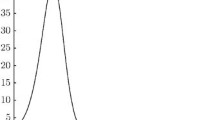Abstract
A simple, quasi-static model for convergence between afferent flows of influences at the neuronal membrane is presented. Interaction between afferent flows reaching chemical synapses of different types is examined. It was found that the pattern of this interaction diverges from algebraic summation of separate effects. The mechanism underlying action between internal negative feedbacks constitutes the basis for this phenomenon.
Similar content being viewed by others
Literature Cited
A. E. Valeev, S. V. Vrublevskii, and N. I. Chernevskaya, “GABA-activated neuronal conductance in the mammalian cerebellum,” Neirofiziologiya,18, No. 6, 836–839 (1986).
G. A. Vartanyan and N. N. Vasilevskii, “Measurement of synaptic processes and neuronal transmitter function,” in: Synaptic Processes [in Russian], Nauk. Dumka, Kiev (1968), 183–199.
N. I. Kalinina, G. G. Kurchavyu, and B. T. Ryabov, “Reversal potential of monosynaptic EPSP in frog motoneurons,” Neirofiziologiya,18, No. 4, 534–542 (1986).
E. A. Kiyatkin and M. Kol'dits, “Functional reorganization of chemically sensitive central neurons,” Usp. Fiziol. Nauk.,17, No. 3, 108–127 (1986).
P. G. Kostyuk, “The Neuron” in: Human and Animal Physiology [in Russian], Nauka, Moscow (1972), Vol. 10, Vol. 10, pp. 5–39.
S. Kuffler and J. Nichols, From the Neuron to the Brain [Russian translation], Mir, Moscow (1979).
E. Kandel Cellular Bases of Behavior [Russian translation], Mir, Moscow (1980).
A. M. Polyakov, “Information reception in some types of neurons,” Fiziol. Zh. SSSR,69, No. 1, 15–18 (1983).
A. M. Polyakov and V. V. Ushakov, “Effects of parameters of after-hyperpolarization in neuronal spike activity,” Fiziol. Zh. SSSR,68, No. 10, 1451–1453 (1982).
V. I. Skok and V. L. Savich, “Neuronal properties and synaptic transmission in the sympathetic ganglion,” in: Synaptic Processes [in Russian], Nauk. Dumka, Kiev (1968), pp. 109–120.
A. I. Shapovalov, Cellular Mechanisms of Synaptic Transmission, Meditsina, Moscow (1966).
A. I. Shapovalov, “Synaptic mechanisms of suprasegmental control of motoneurons of the spinal cord,” in: Mechanisms of Descending Control over Spinal Cord Activity [in Russian], Nauka, Leningrad (1971), pp. 59–69.
J. Eccles, Physiology of Nerve Cells [Russian translation], Inostr. Lit., Moscow (1959).
J. A. Boulant, “Hypothalamic mechanisms of thermoregulation,” Fed. Proc.,40, No. 14, 2843–2850 (1981).
A. S. Finkel and S. J. Redman, “The synaptic current evoked in cat spinal motoneurones by impulses in single group Ia axons,” J. Physiol.,342, 615–632 (1983).
D. Gardner and C. F. Stevens, “Rate-limiting step of inhibitory post-synaptic current decay in Aplysia buccal ganglia,” J. Physiol.,304, 145–164 (1980).
H. M. Gerchenfeld and D. Paupardin-Tritsch, “Ionic mechanisms and receptor properties underlying the responses of molluscan neurone to 5-hydroxytryptamine,” J. Physiol.,243, No. 2, 427–456 (1974).
K. Hattori, N. Akaike, Y. Oomura, and Sh. Kuraoka, “Internal perfusion studies demonstrating GABA-induced chloride responses in frog primary afferent neurones,” Am. J. Physiol.,246, No. 3, C259-C265 (1984).
J. S. Kehoe, “Analysis of a “resting” potassium permeability that can be synaptically reduced,” J. Physiol.,244, No. 1, 23P-24P (1975).
J. Votava, “Slow synaptic excitation in symapthetic ganglion cells: evidence for synaptic inactivation of potassium conductance,” Science,170, No. 3959, 755–758 (1970).
F. F. Weight and A. Padjen, “Slow synaptic inhibition: evidence for synaptic inactivation of sodium conductance in sympathetic ganglion cells,” Brain Res.,55, No. 1, 219–224 (1973).
Additional information
Institute of Chemical Physics, Academy of Sciences of the USSR, Moscow. Translated from Neirofiziologiya, Vol. 20, No. 4, pp. 503–509, July–August, 1988.
Rights and permissions
About this article
Cite this article
Polyakov, A.M. Model of interaction at chemical synapses. Neurophysiology 20, 373–378 (1988). https://doi.org/10.1007/BF02198446
Received:
Issue Date:
DOI: https://doi.org/10.1007/BF02198446




